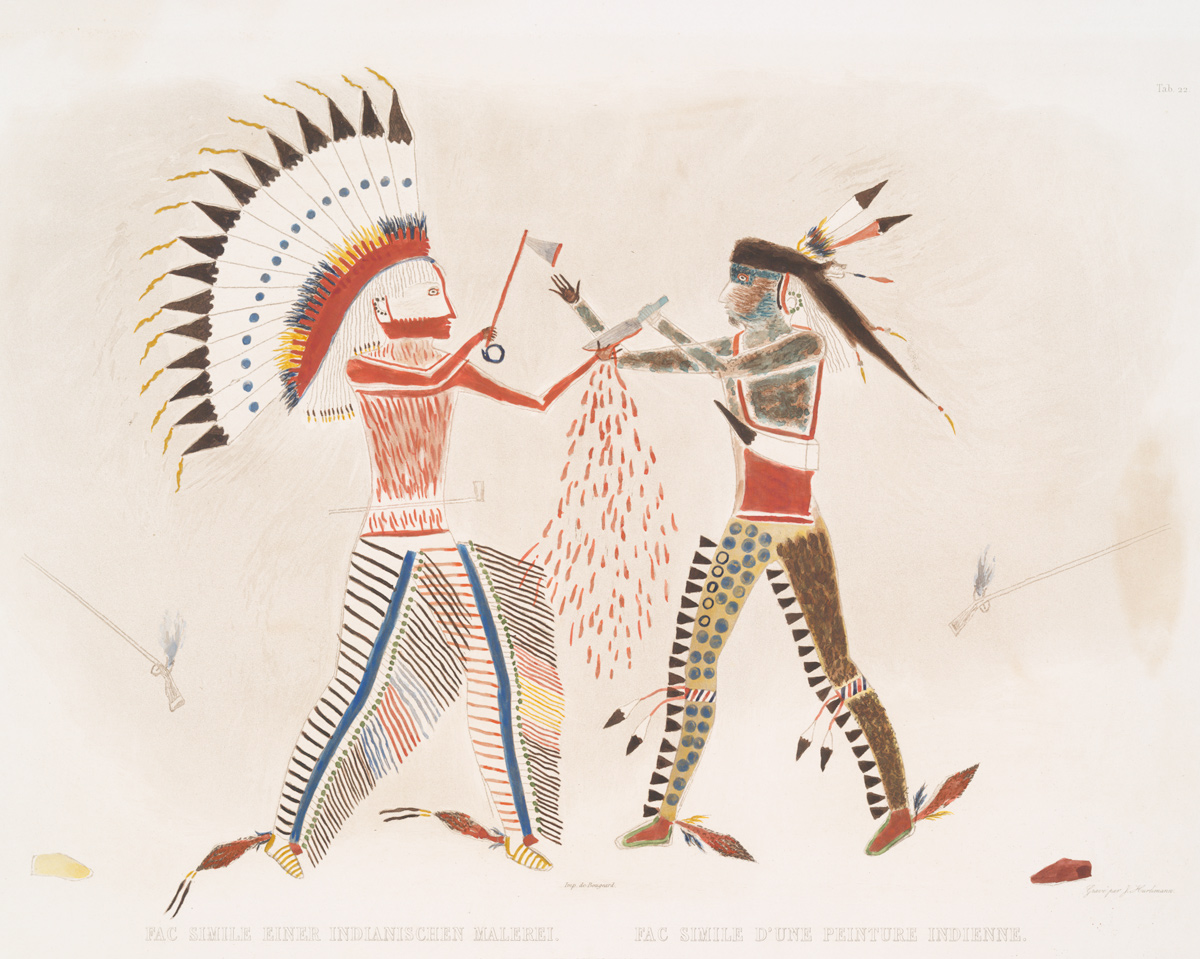The enlisted men at Wood River, Illinois enjoy spring-like weather while the captains are away at St. Louis or Cahokia. During this time, Clark finalizes questions about the war tactics of the Native Nations they will soon meet.
Mató-Tópe’s Battles
Fac Simile of an Indian Painting
Karl Bodmer (1809–1893) from an original by Mató-Tópe (Four Bears)
Rare Book Division, The New York Public Library.[1]“Fac simile einer indianischen malerei. Fac simile d’une peinture indienne. Fac simile of an Indian painting.” New York Public Library Digital Collections. Accessed August 25, 2019. … Continue reading
Of Mató-Tópe, George Catlin wrote:
The next and second chief of the tribe, is Mab-to-toh-pa (the four bears). This extraordinary man, though second in office is undoubtedly the first and most popular man in the nation. Free, generous, elegant and gentlemanly in his deportment-handsome, brave and valiant ; wearing a robe on his back, with the history of his battles emblazoned on it ; which would fill a book of themselves, if properly translated.[2]George Catlin, Letters and Notes on the Manners, Customs, and Condition of the North American Indians (London: Tosswill and Myer, 1841) 1:92.
Indian War Tactics
Inquiries relitive to the Indians of Louisiania.
. . . .
7th. War
. . . .
What is the ceremony of declareing war, and making peace; or forming alliancies?
What the ceremony of setting out and the return of the war party?
Do their women ever accompany them on those th[e]ir hostile experditions.
At what season of the year do they usially go to war?
In what manner are those war parties organised?
What is their Disipline and the regulations by which they are governed?
Do they burn or torture their prisoners?
Do they eat the flesh of their prisoners?
Do they ever adopt their Prisoners as members of their Nation?
What are their implements of war, how do they prepare and how use them?
—William Clark[3]Undated and unsigned list written in Clark’s hand. Donald Jackson, ed. Letters of the Lewis and Clark Expedition with Related Documents: 1783-1854, 2nd ed. Urbana: University of Illinois Press, … Continue reading
Weather Diary
Therm at rise
weather wind Therm at 4 Oclk weather wind River 20 above 0 fair N E 46 above 0 fair N E rise 7 in. —Meriwether Lewis and William Clark[4]To assist the reader, the editor of this web page has omitted the date column, merged the “River” columns, and spelled out some abbreviations.
Experience the Lewis and Clark Trail
The Lewis and Clark Trail Experience—our sister site at lewisandclark.travel—connects the world to people and places on the Lewis and Clark Trail.
Plan a trip related to March 17, 1804:

Winter Camp at Wood River (Camp Dubois) is a High Potential Historic Site along the Lewis and Clark National Historic Trail managed by the U.S. National Park Service. The site, near Hartford, Illinois, is managed as Lewis and Clark State Historic Site and is open to the public.
Notes
| ↑1 | “Fac simile einer indianischen malerei. Fac simile d’une peinture indienne. Fac simile of an Indian painting.” New York Public Library Digital Collections. Accessed August 25, 2019. http://digitalcollections.nypl.org/items/510d47da-c449-a3d9-e040-e00a18064a99. |
|---|---|
| ↑2 | George Catlin, Letters and Notes on the Manners, Customs, and Condition of the North American Indians (London: Tosswill and Myer, 1841) 1:92. |
| ↑3 | Undated and unsigned list written in Clark’s hand. Donald Jackson, ed. Letters of the Lewis and Clark Expedition with Related Documents: 1783-1854, 2nd ed. Urbana: University of Illinois Press, 1978), 160. |
| ↑4 | To assist the reader, the editor of this web page has omitted the date column, merged the “River” columns, and spelled out some abbreviations. |



